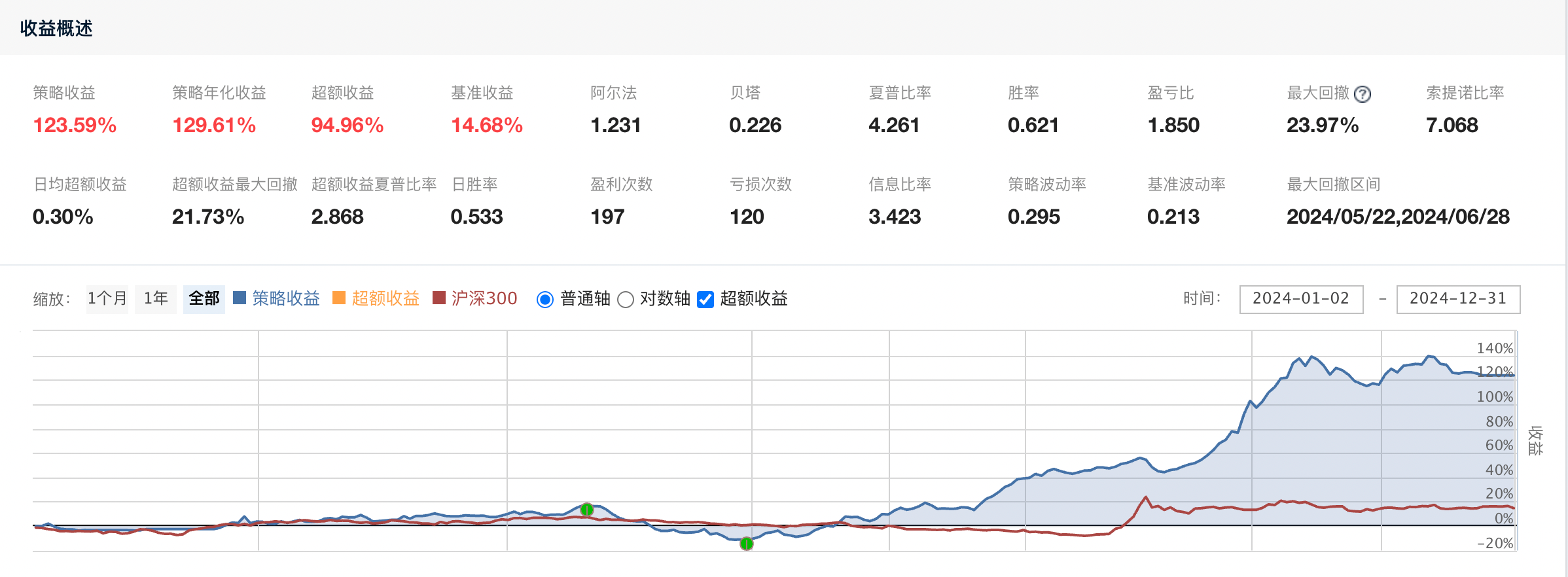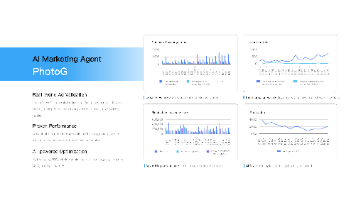量化策略分享之ST股弱转强,回测年化123%
本策略的核心是精选ST股票,国九条过滤,防止直接暴雷退市,只做ST股票的弱转强,弱转强的认定标准是前日涨停但昨日不涨停,昨日收盘价大于前一日最低价,昨日收盘价大于10日线,昨日成交量大于前一日的成交量但小于前一日成交量的10倍,股价大于1;这类股票强势,有资金介入,能获得超额收益。
·
本策略的核心是精选ST股票,国九条过滤,防止直接暴雷退市,只做ST股票的弱转强,弱转强的认定标准是前日涨停但昨日不涨停,昨日收盘价大于前一日最低价,昨日收盘价大于10日线,昨日成交量大于前一日的成交量但小于前一日成交量的10倍,股价大于1;这类股票强势,有资金介入,能获得超额收益。
回测数据如下:

*回测数据只作测试用,不代表未来实际收益
1、策略初始化配置
主要定义了持股数量、当日股票池、运行周期等等
g.stock_num=5
g.today_list=[]#当日股票池
run_daily(perpare,time="9:25")
run_daily(buy,time="9:30")
run_daily(sell,time='13:00')
run_daily(sell,time='14:00')2、选股逻辑
(1)选取全市场所有的ST股票
##获取所有ST股##
def get_st(context):
yesterday=context.previous_date
stockList=get_all_securities(types='stock',date=yesterday).index
st_data=get_extras('is_st',stockList, count = 1,end_date=yesterday)
st_data = st_data.T
st_data.columns = ['is_st']
st_data=st_data[st_data['is_st']==True]
df = st_data.index.tolist()
return df (2)1、4、12月份进行国九条过滤
1、4、12月份进行国九条过滤,避免直接暴雷和退市风险
#1 4 12月 国九
singal=today_is_between(context)
if singal==True:
print(f'筛选前:{len(stk_list)}')
stk_list=GJT_filter_stocks(stk_list)
print(f'筛选后:{len(stk_list)}')
def today_is_between(context):
today = context.current_dt.strftime('%m-%d')
if ('01-15' <= today) and (today <= '01-31'):
return True
elif ('04-15' <= today) and (today <= '04-31'):
return True
elif ('12-15' <= today) and (today <= '12-31'):
return True
else:
return False(3)国九条过滤条件
市值在10到500亿,归属于母公司所有者的净利润大于0,净利润大于0,营业收入大于1亿,roe大于0,roa大于0
##国九条筛选##
def GJT_filter_stocks(stocks):
# 国九更新:过滤近一年净利润为负且营业收入小于1亿的
# 国九更新:过滤近一年期末净资产为负的 (经查询没有为负数的,所以直接pass这条)
q = query(
valuation.code,
valuation.market_cap, # 总市值 circulating_market_cap/market_cap
income.np_parent_company_owners, # 归属于母公司所有者的净利润
income.net_profit, # 净利润
income.operating_revenue # 营业收入
#security_indicator.net_assets
).filter(
valuation.code.in_(stocks),
valuation.market_cap.between(10, 500),
income.np_parent_company_owners > 0,
income.net_profit > 0,
income.operating_revenue > 1e8,
indicator.roe>0,
indicator.roa>0,
)
df = get_fundamentals(q)
final_list=list(df.code)
return final_list(4)技术指标筛选
昨日收盘价大于前一日最低价,昨日收盘价大于10日线,昨日成交量大于前一日成交量但小于前一日成交量的10倍,股价大于1
def filter_stocks(context, stocks):
yesterday = context.previous_date
df = get_price(
stocks,
count=11,
frequency='1d',
fields=['close', 'low', 'volume'],
end_date=yesterday,
panel=False
).reset_index()
# 按股票分组处理
grouped = df.groupby('code')
# 计算技术指标
ma10 = grouped['close'].transform(lambda x: x.rolling(10).mean()) # 10日均线
prev_low = grouped['low'].shift(1) # 前一日最低价
prev_volume = grouped['volume'].shift(1) # 前一日成交量
# 构建筛选条件
conditions = (
(df['close'] > prev_low) & # 多头排列
(df['close'] > ma10) & # 10日线上方
(df['volume'] > prev_volume) & # 放量
(df['volume'] < 10 * prev_volume) & # 成交量未暴增
(df['close'] > 1) # 股价>1
)
# 获取最新交易日数据
latest_data = df[df['time'] == yesterday]
valid_stocks = latest_data[conditions]['code'].unique().tolist()
return valid_stocks(5)弱转强认定
前日涨停但昨日不涨停的股票
##筛选昨日不涨停的股票##
def rzq_list(context,initial_list):
# 文本日期
date = context.previous_date #昨日
date = transform_date(date, 'str')
date_1=get_shifted_date(date, -1, 'T')#前日
# 昨日不涨停
h1_list = get_ever_hl_stock(initial_list, date)
# 前日涨停过滤
elements_to_remove = get_hl_stock(initial_list, date_1)
zb_list = [stock for stock in h1_list if stock in elements_to_remove]
return zb_list(6)开盘认定
选择开盘低开3个点左右,换手率高的股票
df['open_now'] = [current_data[s].day_open for s in stk_list]
df = df[(df['open_now']/df['close'])< 1.01] #低开越多风险越大,选择3个多点即可
df = df[(df['open_now']/df['close'])> 0.95]
stk_list = list(df.index)
if len(stk_list)==0:
return
df=get_valuation(stk_list, start_date=context.previous_date,
end_date=context.previous_date,
fields=['turnover_ratio', 'market_cap','circulating_market_cap']
)
df = df.sort_values(by='turnover_ratio', ascending=False)3、调仓逻辑
(1)买入
可用余额平均分配金额买入
def buy(context):
target=g.today_list
hold_list = list(context.portfolio.positions)
num=g.stock_num-len(hold_list)
if num==0:
return
target=[x for x in target if x not in hold_list][:num]
if len(target) > 0:
# 分配资金(等权重买入)
value=context.portfolio.available_cash
cash_per_stock = value / num
current_data = get_current_data() # 实时数据对象
for stock in target:
# 排除停牌和涨跌停无法交易的股票
if current_data[stock].paused or \
current_data[stock].last_price==current_data[stock].low_limit or \
current_data[stock].last_price==current_data[stock].high_limit:
continue
order_value(stock, cash_per_stock) # 按金额买入[6](@ref)
log.info (f"买入 {stock}")(2)卖出
第二天未涨停并且亏损超过3%或者盈利大于0或者昨日涨停并且当前不是跌停,满足上述条件就卖出
def sell(context):
hold_list = list(context.portfolio.positions)
if hold_list:
current_data = get_current_data()
yesterday=context.previous_date
# 批量获取昨日涨停数据
df_history = get_price(hold_list,end_date=yesterday,frequency='daily',fields=['close', 'high_limit'],count=1,panel=False)
df_history['avg_cost']=[context.portfolio.positions[s].avg_cost for s in hold_list]
df_history['price']= [context.portfolio.positions[s].price for s in hold_list]
df_history['high_limit']= [current_data[s].high_limit for s in hold_list]
df_history['low_limit']= [current_data[s].low_limit for s in hold_list]
df_history['last_price']= [current_data[s].last_price for s in hold_list]
# 条件1:未涨停
cond1 = (df_history['last_price'] != df_history['high_limit'])
# 条件2.1:亏损超过3%
ret_matrix = (df_history['price'] / df_history['avg_cost'] - 1) * 100
cond2_1 = ret_matrix < -3
# 条件2.2:盈利超过0%
cond2_2 = ret_matrix > 0
# 条件2.3:昨日涨停
cond2_3 = (df_history['close'] == df_history['high_limit'])
# 组合卖出条件(逻辑或运算)
sell_condition = cond1 & (cond2_1 | cond2_2 | cond2_3)
# 生成卖出列表(过滤无效订单)
sell_list = df_history[
sell_condition &
(df_history['last_price'] > df_history['low_limit'])
].code.tolist()
# 批量下单
for s in sell_list:
order_target_value(s, 0)
print(f'卖出 {s} | 成本价:{context.portfolio.positions[s].avg_cost:.2f} 现价:{context.portfolio.positions[s].price:.2f}')
print('-'*50)这篇文章主要分享ST股弱转强策略,主要的逻辑在选股条件以及卖出条件上,适合小仓位的风险投资者。
如果有不懂的,欢迎找我一起交流,加入量化交易大家庭
更多推荐
 已为社区贡献6条内容
已为社区贡献6条内容










所有评论(0)